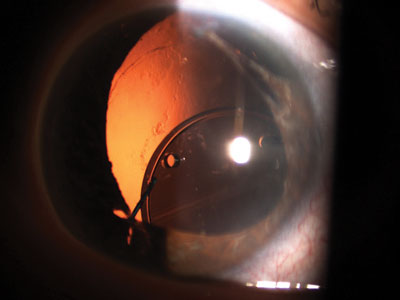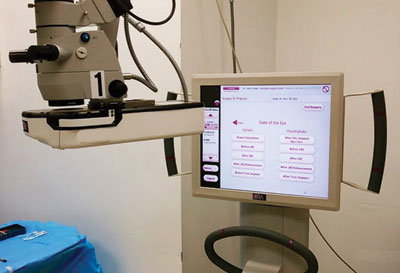Familiarity with old and new techniques and technologies helpful for surgeons
Practitioners will benefit from learning about older concepts in ophthalmology.
Click Here to Manage Email Alerts
 Uday Devgan |
Ophthalmology is a constantly evolving specialty, particularly with regards to procedures such as cataract surgery. While we are always striving to learn new techniques and technologies to provide better visual outcomes for our patients, it is important for us to also know and understand the older methods, instruments and history of ocular surgery.
Manual extracapsular surgery
With the advent of ultrasonic phacoemulsification and foldable lens implants, it may seem logical to abandon the manual technique of extracapsular cataract surgery, which is typically done with a larger incision that requires sutures for closure. But there is utility in knowing how to perform a manual extracapsular surgery, such as for the patient with a very dense brunescent cataract in the presence of a weak corneal endothelium. In this case, every effort to preserve the endothelial cells is made to avoid pseudophakic bullous keratopathy and future corneal transplantation. Sometimes during a challenging cataract case, there is a need to convert from phacoemulsification to a larger-incision extracapsular technique. In addition, studies have now shown that for the dense cataracts seen during charity surgery mission trips, manual techniques can be faster and safer than phacoemulsification.
Learning these procedures also benefits surgeons because it helps them to develop skill sets, such as fine suturing ability, that they would not ordinarily use with less invasive procedures. Placing sutures to seal an extracapsular incision in an astigmatically neutral way is not easy, and it is a skill that some younger surgeons are lacking. To address this, I require my ophthalmology residents to throw at least 500 sutures in the wet lab before suturing in the operating room.
In the past dozen years, I have only rarely found it necessary to perform a manual extracapsular cataract surgery. However, in my teaching role, I have made sure that every one of the more than 100 residents I have personally trained has learned and performed at least a few of these manual surgeries.
Older technology products
We can learn a lot from the older technology products, such as IOLs, used in cataract surgery. Looking back at history, we see that the evolution of IOLs came in many steps, including anterior chamber models, iris clip designs and posterior chamber lenses, with material type and lens architecture changing throughout the years. Even the youngest surgeons will encounter these older-design IOLs in their practices, and knowing the specific details can help with future surgery.
I had a patient referred to me recently for an IOL exchange because she had a decentered lens with a damaged haptic. Upon examination at the slit lamp, I recognized the four positioning holes in the optic, but I asked my colleagues about it and they said that it was likely a Shearing J-loop three-piece IOL made of PMMA. This is important to know because the PMMA material cannot be easily cut in the eye, so the lens requires a large 6-mm incision for explantation. Knowing this beforehand simplified my surgery and made for a better outcome for the patient. Learning about these products helps us to come up with newer and better lens designs for the future.
 This decentered lens has positioning holes in the optic and is made of rigid PMMA, which means that it cannot easily be cut in half inside the eye; rather it must be explanted whole. Images: Devgan U |
Test driving new technology
The amount of engineering innovation in ophthalmology is simply amazing, with new technologies surfacing every year. I am convinced that the only way for me to properly evaluate a new technology is to take it for a test drive both in the lab and in the operating room. If enough surgeons see the benefit of the product, then it will succeed and be widely accepted as a better, more accurate or safer method.
We have all wished for the ability to deliver exact refractive outcomes for all of our cataract patients, but despite our best efforts, achieving a plano refraction every time is elusive. It would be nice to be able to measure these eyes on the operating room table during surgery to confirm the lens power, adjust the position of a toric lens or extend the arc length of a limbal relaxing incision. In that light, I have been evaluating an intraoperative aberrometer that is mounted to the surgical microscope. It allows for all of these measurements, and it makes suggestions for lens power calculation and astigmatic treatment. It may take time before independent studies confirm that intraoperative aberrometry improves surgical outcomes, but I think it will. While new technologies like this are not perfect, I encourage you to test drive them in your own clinic and provide valuable feedback to the manufacturers to assist them in fine- tuning the results. The best technologies will stand the test of time.
 This microscope-mounted intraoperative aberrometer is used to measure the refraction and astigmatism of the eye during cataract surgery. |
I can envision a time, when I am ready for my own cataract surgery, when we will have new lens designs that provide the accommodation of youth — new designs that incorporate all of the things we have learned from decades of IOL evolution. Couple that with intraoperative aberrometry and keratometry to deliver a perfect refractive result. And finally, I will make sure that my surgeon is also familiar with the older techniques of surgery, just in case.

- Uday Devgan, MD, is in private practice at Devgan Eye Surgery in Los Angeles and Beverly Hills. He can be reached at 11600 Wilshire Blvd., Suite 200, Los Angeles, CA 90025; 800-337-1969; email: devgan@gmail.com; website: www.DevganEye.com.
- Disclosure: No products or companies are mentioned that would require financial disclosure.
